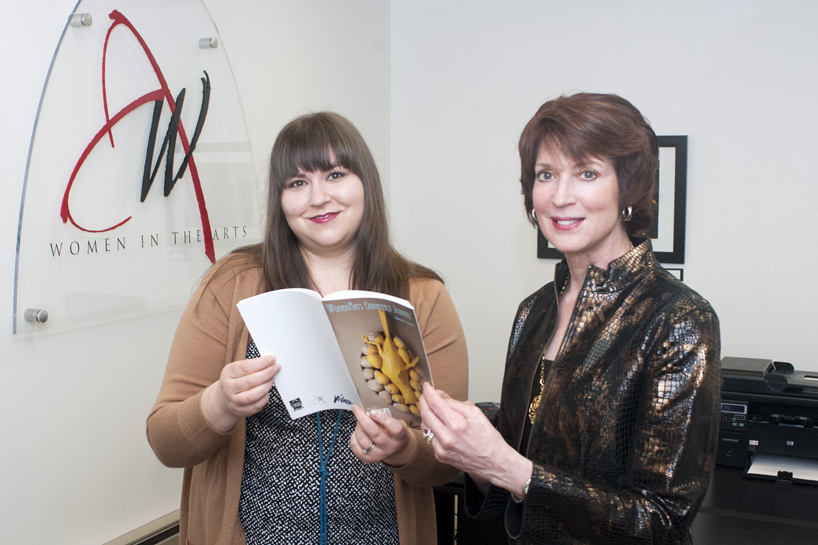
WomenArts Quarterly Journal Managing Editor Lindsay Shadwell (left) holds the newest issue with Senior Editor and UMSL Professor Barbara Harbach. WomenArts is entering its fourth year in publication and has found a niche in independent bookstores. (Photo by August Jennewein)
Despite just four years in circulation, WomenArts Quarterly Journal has found a reach beyond the boundaries of the University of Missouri–St. Louis campus.
The publication can be found in more than 50 bookstores from coast-to-coast and receives hundreds of submissions each month from creatresses all around the globe. The quarterly is the product of UMSL’s Vivace Press, founded in part by Senior Editor and Professor Barbara Harbach and Managing Editor Lindsay Shadwell.
The quarterly gets most of its circulation through independent bookstores. The publication’s distributor places the journal with retailers, including four stores in San Francisco, and several in major cities like New York, Chicago and Portland, Ore. University towns like Ann Arbor, Mich., and Madison, Wisc., are also on the list. Many independent bookstores have shuttered in recent years, but those that remain offer a ripe market for a publication like the journal.
“We create a very niche product and bookstores are niche retail venues,” said Shadwell, who is a graduate of UMSL’s MFA in Creative Writing program. “You go into an independent bookstore to get advice from booksellers about what they recommend. I think we do well in bookstores because we’re not People magazine or anything people can get at the grocery store.”
Just as independent bookstores fill a niche market, WomenArts caters to a market that few journals do. Many women-focused journals might center on art or writing or music. WomenArts combines all of those, with music or dance interviews and reviews and 10 full-color pages of visual artwork in addition to literary fiction, nonfiction and poetry.
“There are not a lot of journals for women in the arts,” Harbach said. “There are journals for women in music, and women in literature, but not a lot for women across the board.”
The journal’s niche is closely related to its mission of supporting female artists of numerous genres. Harbach started the journal in part because female artists remain underrepresented in terms of publishing and publicity. Women represent 51 percent of visual artists working today and earn half of the MFA degrees conferred in the US. But only a third of the pieces on display at US art galleries are produced by women and only five percent of works on display in art museums are women-produced, according to the National Museum of Women in the Arts. The literary world does offer women more opportunities, but disparities still exist depending on the publication, Harbach said.
Despite the journal’s welcoming mission, getting published is serious business. The journal gets about 200 submissions every month, and only accepts about one to three percent for publication. Journal editor Lindsay Shadwell also offers feedback and encouragement if a piece shows promise but isn’t ready for publication, something many journals don’t do.
“We always encourage people to resubmit their work and keep doing what they’re doing,” Shadwell said. “There’s more at stake as far as creating and promoting community in our journal than there would be at the average mixed-gender journal.”
Harbach and Shadwell also bring their arts message to the St. Louis community as co-hosts of the weekly radio show Women in the Arts at the U. The program broadcasts Monday morning on UMSL Student Radio, and is also available as a podcast. In fall of 2014, Women in the Arts will host its third conference at UMSL. Information about the conference will be available in the coming months.














